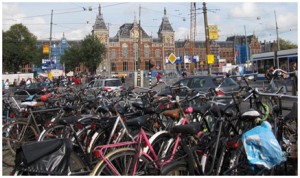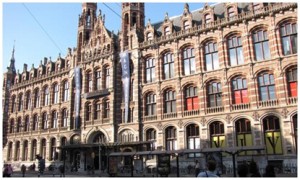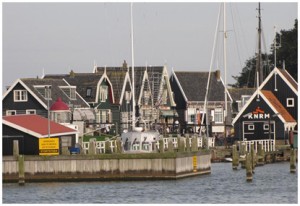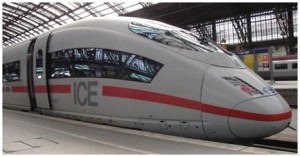Archive for December, 2010
GOP Rising Stars Marco Rubio & Nikki Haley: Images From Two Contrasting Profiles
Posted by admin in January 2011 on December 24, 2010
By Kollengode S. Venkataraman e-mail:Â thepatrika@aol.com
In the 2010 elections rightwing mouth pieces (Fox, Rush Limbaugh, Sean Hannity and others) enthusiastically endorsed two “ethnic†candidates, Marco Rubio in Florida and Nikki Haley in South Carolina. Rubio, the speaker of the Florida Assembly, set his sights as the US senator; Nikki Haley, a member of South Carolina state assembly, pursued the governorship in South Carolina. Both were the darlings of the rightwing Tea Partiers. Finally, the GOP seems to recognize the changed social fabric of the US. Better late than never.
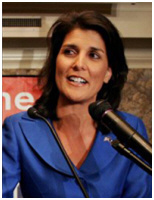 Haley, born to Sikh immigrant parents from India, was Namrata Nikki Randhawa. After her marriage and after entering electoral politics, she dropped the very Indian “Namrata†and “Randhawa†in her name and became Nikki Haley.
Haley, born to Sikh immigrant parents from India, was Namrata Nikki Randhawa. After her marriage and after entering electoral politics, she dropped the very Indian “Namrata†and “Randhawa†in her name and became Nikki Haley.
Rubio and Haley ran disciplined campaigns, and thanks to the anti-Democratic sentiment, they won big. They deserve our admiration.
Even as both represented the minorities in American electoral politics, their journeys were sharply different. Rubio is the son of Cuban exiles and was born in Miami, Florida and is fluent in Spanish. He grew up in what can be called a working class American home — his father was a bartender and his mother worked as a hotel housekeeper in Las Vegas, Nevada. After  attending Santa Fe Community College, he earned degrees in political science 1993 and law degree 1996 from universities in Florida. Rubio served as a City Commissioner for West Miami before elected to the Florida House of Representatives in 2000. In November 2006, he became the Speaker of the Florida State House for 2006-08.
attending Santa Fe Community College, he earned degrees in political science 1993 and law degree 1996 from universities in Florida. Rubio served as a City Commissioner for West Miami before elected to the Florida House of Representatives in 2000. In November 2006, he became the Speaker of the Florida State House for 2006-08.
Haley, though a minority in the ethnic sense, belongs to a “privileged†minority in the American context. She is like many children born to professional Indian immigrants. Born to college educated Indian parents – her father was a professor in chemistry — Haley went to Clemson University, earned a degree in accounting, and worked as an accounting supervisor in Charlotte, NC. Her mother was an entrepreneur. According to her campaign, Haley worked in her mother’s garment business and built it into a multimillion dollar enterprise. She was active in many business and social organizations such as chambers of commerce, Rotary Club…
The victory speeches the two delivered and the campaign they ran sharply brought out the contrasts in their journeys to where they got. Remember, political campaigns and rallies are heavily scripted and stick to well-tested talking points. Campaign managers spend lot of time and effort to manage the “optics†of the event captured on video cameras.  Below are the video clips of the victory speeches of Rubio and Haley in full. (Note: if you want to watch their victory speeches, copy the web address and paste it at your URL site and hit return.)
1. Haley’s Speech here: www.youtube.com/watch?v=qBrO7VmB5fM
2.  Rubio’s Speech here: www2.counton2.com/news/2010/nov/03/governor-elect-nikki-haleys-victory-speech-ar-1045771/
Rubio, proud of his status as the son of Cuban exiles, made passionate references to his father and mother in his victory speech. He reaffirmed his identity, as the one belonging to “the community of exiles,†and that, he, Marco Rubio, always will be the son of [Cuban] exiles.†He also talked about his bartender father and housemaid mother.
In Haley’s bland victory speech, there was no reference to her roots, only passing references to her parents as she thanked her and her husband’s parents and brothers.
Earlier in the campaign, Haley told “I was born and raised with the Sikh faith, my husband and I were married in the Methodist Church, our children… … have been baptized in the Methodist Church, and currently we attend both,†she said. But soon, she was running away from her Sikh identity when she did not even acknowledge that she and her husband, Michael Haley, were married in two ceremonies, one Sikh and the other at a Methodist church.
Earlier in her political life, Haley was comfortable publicly embracing both religions. But as the campaign progressed, she talked of having “converted to Christianity†before her wedding in 1996, when she was baptized as a Methodist. To a question “Is Nikki a Christian?†in her website, she also changed the wording in the answer: From an answer that references to “Almighty Godâ€, she changed it to one that references “Christ.â€
The contrast between Rubio and Haley is striking. As both climbed higher on the political ladder, Rubio was quite comfortable about his roots. Haley, uncomfortable with her ethnic identity, was running away from her roots. Haley is not unique in this. Bobby Jindal (Piyush, 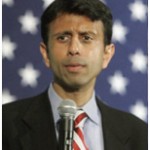 before he became Bobby) set the trend when he ran for the office of the governor of Louisiana. When Jindal as governor was invited to the White House Diwali function — which has now lost all its religious significance — he did not show up. Probably because of the bad optics of video clips filling the Louisiana airwaves in election commercials showing a very brown Jindal in a Indian “Hindu†function in the midst of other brown Indians. That will not sit well in the deeply “Southern†Louisiana.
before he became Bobby) set the trend when he ran for the office of the governor of Louisiana. When Jindal as governor was invited to the White House Diwali function — which has now lost all its religious significance — he did not show up. Probably because of the bad optics of video clips filling the Louisiana airwaves in election commercials showing a very brown Jindal in a Indian “Hindu†function in the midst of other brown Indians. That will not sit well in the deeply “Southern†Louisiana.
In the electoral politics for state-wide offices in the US, multiculturalism and diversity is still a novelty.
In Jindal’s defence, Jindal, a Brown University graduate in biology, in his anxiety to get elected as the governor of Louisiana, was also running away from Darwin’s Natural Selection and embraced the Judeo-Christian concepts of creation in which the universe is only 6,000 years old, give or take a few centuries. OK, All is fair in war, love, and in elections.
Jindal and Haley running away from their roots reminded me of David Chappelle’s wickedly witty, cynical skit (video reference: www.youtube.com/watch?v=wITchV88Gjk&feature=related ) (Note: copy the web address and paste it at your URL site and hit return to go to the YouTube clip. This is wicked and hilarious.)
In the skit, a congenitally blind Black man, raised by racist whites since his childhood, behaves more White than the whites themselves. He hates Blacks more than the Whites themselves.
The discomfort of elected officials of Indian origin in the US such as Nikki Haley and Bobby Jindal with their own cultural identity is baffling. The track record of nearly three million Indian-Americans is nothing to be embarrassed about. They establish themselves on their individual strengths alone as small business people, healthcare professionals, engineers, IT professionals, lawyers, researchers, depending only on their education and professional skills. And yes, also as cab drivers, hotel employees, restaurant workers, and airport employees pushing wheelchairs carrying physically disabled passengers, with their sweat equities.   ♦
The Iraq War in the Indian-Immigrant Context Seen Through a Play
Posted by admin in January 2011 on December 24, 2010
By Nina Ahuja, Pittsburgh, PA
Editor’s Note: Nina Ahuja, is a physician at UPMC in Pittsburgh. She grew up in Fox Chapel, and went to George Washington University before earning her medical degree from George Washington University.
RON is a play about the patriotism and loyalty of an Indian immigrant family and their US-born son who feels compelled to serve his country by fighting in Iraq and Afghanistan. The play is set in the backdrop of the current American war in Iraq and Afghanistan. Ron (Ronobir Mitra), the only son of an Indian immigrant family, is a member of the US National Guard, deployed in Iraq. Although Ron’s parents were not happy with his decision to join the army, they respect his sense of duty to his country and allow him to serve.
The play shows how the family of Ron, his parents Animesh and Shanti Mitra go on with their life in the US while Ron is in the battlefield. His absence and concern over his well-being are issues his parents, extended family, and close friend Bidisha share and express in the play.
RON, created by Natya Bharati in Washington DC, was staged at the S.V. Temple on October 23, 2010 under the auspices of the Triveni International Club.
The storyline of the play begins on the morning of a baby shower for Bidisha, Ron’s childhood friend. Ron’s parents host the baby shower on his behalf. As the guests arrive, the hope and excitement of a new life is shared among all of Ron’s family members and friends and they all hold hope that Ron will call during the baby shower.
During the baby shower, the evening takes an unexpected turn when Surojit Biswas, a writer and journalist from Calcutta challenges Animesh and other guests about their loyalty and beliefs, and their fundamental moral values. The party rapidly changes from one filled with hope and excitement to a deep revelation of each individual’s inner wars and the internal battles that each has been fighting. The baby shower takes the final twist when news from Iraq reaches conveying Ron’s death.
The play nicely portrays the inner war that each individual faces for physical and emotional survival by focusing on the larger issue of the political climate and the journey of the son of an Indian immigrant family into war. The central message emanating from RON is that though the wars we fight are not always just and fair, we still fight them anyway.
The battles of identity, belonging, duty, personal loss, and happiness, are all explored through the characters at the baby shower. Surojit Biswas, played by Paul Singh, was fabulous at probing his fellow friends to address these issues and reveal their inner struggles as he drank himself into a verbal outpouring revealing his emotional struggle. Animesh and Shanti Mitra (played by Manoj Tiwari and Meera Narasimhan) did an exceptional job as Ron’s parents. Their portrayal of the conflict parents feel between what they think is right for their children versus allowing their children to pursue their own interest was realistic, and one that many parents in the audience identified with. The glimpses of Ron, played by Gopi Ganji, were both poignant and challenging.
The younger generation who came to the program came away feeling quite in awe of their ability to identify with the messages of patriotism, free will, and love of family portrayed in this play. Many in the audience who were mostly immigrant parents could also identify with the portrayals of the inner battles they have all been through.
After their three-hour performance, Natya Bharati’s artists stayed to answer questions from the audience and personally interact with them before their trip back to DC that very same night.
Dr. Juginder and Dolly Luthra of the Triveni International Club, with help from all the board members of Triveni hosted and emceed the program. Amit Grover, the Triveni Club Secretary, sold extra tickets to the show at the door.
RON is written by playwright, Sudipta Bhawmik and directed by Suma Muralidhar. Bhawmik is a well-known actor, director and playwright in the DC area.
Suma Muralidhar, a veteran actor in DC area, made her directorial debut with RON. Mamta Kukreti was in charge of the production with help from Rakesh Tandon, Suma Muralidhar, Guneet Kaur, Neeru Tandon, Siddhesh Pai-Raikar, Madhuri Subramaniam, Hari Easwaran, Yatin and Chetna Gola.
For all the efforts that went to bring the program to Pittsburgh, the turnout could have been better. The auditorium was only half full
O Henry’s Chairs
Posted by admin in January 2011 on December 24, 2010
Mandira Chattopadhyay, DuBois, PA
e-mail: mchattopadhy@bsu.edu
If you are a keen observer walking past O Henry’s house, you could not but help notice the glow of happiness it casts over the busy streets of downtown Austin; you could not help but look up at this little house and dream about O Henry, known as William Sydney Porter, living with his beloved wife.
Most readers know Porter under the pen name “O. Henry.â€Â  His reputation as a master of short stories remains even after a century and a half. Growing up in Greensboro, North Carolina in 1862, Porter held a number of jobs from drug store clerk to cartoonist. He relocated to Texas in 1882 and got by as a ranch hand, a bank teller and a journalist. During the last decade of his life Porter created hundreds of short stories that comprise his legacy. His stories are known for their surprise endings. They are set in the various regions where he lived from New York and Texas to Latin America, and hold a mixture of humor and pathos. A few are considered classics of the genre.
“The Gift of the Magi,†for example, tells of a husband and wife, who sell their most prized possessions in order to buy presents for each other. His focus on entertainment can sometimes make the stories feel contrived, and the pressures of publication sometimes show in his work. It is widely believed that Porter produced “The Gift of the Magi†in just a few hours.
I was simply fascinated when I came across O Henry’s tiny little house tucked away between towering modern structures in downtown Austin.  I initially heard of O Henry’s house from the bus driver of the tourist bus as I toured Austin. He noted the contrast of the simple home from the pomp and grandeur of contemporary downtown Austin of Dell and IBM. As I returned to my hotel from the tour, an impulse pushed me toward the house, because I wanted to see to it with my own eyes. .
On my walk there I passed the fancy restaurants and open cafes that line the block. Suddenly amidst the glass boxes and modern facades, I spied a lovely Queen Anne house lost amongst the modern downtown. I heard the house had been moved already once where now sits a big hotel. The house was only a few years old when the Porters rented it in 1893, when it sat on 308 East Fourth St., a few blocks from its present location. Kerosene lamps only lighted it since it was still without gas or electricity. It was a rental in 1930 when it was going to be torn down to make way for other warehouses that had taken over that part of the city. The owner of the house was persuaded to save it, and it was moved to one of Austin’s original parks and deeded to the city. In 1934 it was restored and opened as a museum with some of Porter’s furniture. In 1994-95, further restoration repaired the exterior, the roof, and the front porch, along with four brick chimneys.
Entering the house, I felt the solemn but sweet organ notes that O Henry played were still in the air. As I came in I noticed the photographs of his wife and family on the mantle. The narrow hallway in the house displayed the Rolling Stone, the paper he published in Austin, and some of his books.
I flipped through one of his books and turned to his own account of his marriage. O Henry implored the Dear Fairy to make their wedding night longer: “Just an hour, dear fairy, so we can remember how the grass and the poplar trees looked and the bow of those bonnet strings tied beneath the chin [of Mrs. Porter] . . .†Out the window, I could see one of the city’s many horse-drawn carriages pass. I thought of the happy couple eloping one moonlit night in a borrowed carriage, joking with each other, laughing in spite of her parent’s objections to the match and dreaming of their bright future, which they never expected to be clouded so soon.
In the back of the house I saw a little kitchen with some of the utensils he used. The furniture was chipped and bruised. Each plank in the floor shrieked O Henry’s presence. It seemed incredible that I was able to walk in his room. A cold musty smell came out of the rotten woodwork of the house, but the rich odor of the sweet relationship with his wife still lingered there. As I traversed the room, I still could discern the love and the outstretched arm of his beloved wife. That spirit seemed to hover there.  Their love reminded me of the grand love of Shah Jahan and Mumtaz Mahal as declared in Taj Mahal.  ♦
Diwali at the White House
Posted by admin in January 2011 on December 24, 2010
By Narasimmam Srinivasagam, Upper St. Clair, PA.
Editor’s Note:Â Dr. Srinivasagam is a long-time resident here, having arrived in Pittsburgh in 1965. He ha been working in the Jefferson and Braddock hospitals. He lives in Upper St. Clair with his wife Nancy. Here he recounts the Diwali gala at the White House.
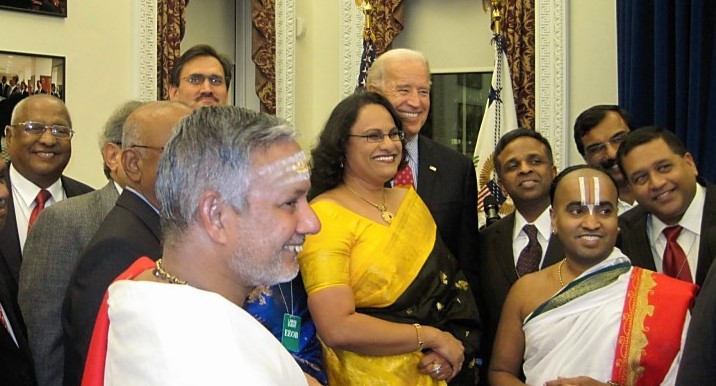
N. Srinivasagam (extreme left) at the Diwali function at the White House with Vice President Joe Biden
On November 5th I received an invitation from my daughter who has recently been appointed to a position at the White House. The invitation was for a reception for the Indian community to celebrate Diwali on November 9th hosted by Vice-President Joe Biden as President Obama was on a state visit to Asia. With much excitement I attended the function along with about 150 fellow Indians from the Washington D.C. area. Some of the guests were from the Sri Shiva Vishnu Temple in DC, whose chairman, Leila Mandava was also present. As a member of the S.V. Temple, I received a warm welcome from everyone gathered.
Vice President Biden welcomed everybody and then the festivities began. The priest form the Sri Shiva Vishnu temple performed the Diwali puja, with Vice President lighting the decorative lamps. A brief, but gracious Bharatanatyam recital followed. Vice President Biden then spoke about the vibrant Indian community across the country and how happy and honored he was to be part of the festivities. After the ceremony, Indian snacks were served and I mingled with other invitees. I had an opportunity to briefly talk to the Vice President and a member of Congress present.
This was an unforgettable experience as an Indian and an American to celebrate this holy holiday at the White House. I was awestruck by grandeur of the place and the magnitude of the event, and was thankful that President Obama and Vice President Biden recognize, as Presidents Bush and Clinton did, the importance of good Indian-American relationship. It was an amazing evening, God Bless America!   ♦
Personally speaking: My love affair with Pittsburgh
Posted by admin in January 2011 on December 24, 2010
By Kamana Mathur e-mail: kamana@mathurlaw.us
 Kamana Mathur, an immigration attorney, was born in Lucknow, and was schooled in the US. She returned to India with her parents and graduated from Lady Sri Ram College, New Delhi. Returning to the US, she earned her law degree from the George Washington University School of Law, while working full-time and raising her son. She worked in the US State Department in New Delhi as a Foreign Service Officer and Consular Officer. She is proud that her son Anuraag completed his tour of duty in Iraq as a US Marine.
Kamana Mathur, an immigration attorney, was born in Lucknow, and was schooled in the US. She returned to India with her parents and graduated from Lady Sri Ram College, New Delhi. Returning to the US, she earned her law degree from the George Washington University School of Law, while working full-time and raising her son. She worked in the US State Department in New Delhi as a Foreign Service Officer and Consular Officer. She is proud that her son Anuraag completed his tour of duty in Iraq as a US Marine.
I would often stand in front of the picture my father had taken many years ago, when I was a little girl in India. It was taken in front of an interesting building, ornate but quite different from the buildings I was used to. Little did I realize then that one day, I would be standing in front of the same building – the Cathedral of Learning in Pittsburgh. After I moved to Pittsburgh, one of my first outings was to visit the imposing building and the nationality rooms in it. I was impressed.
Several weeks ago, as part of my job as an attorney, I drove from Pittsburgh to Washington, D.C. at 3:30 am for a 9:30 am court hearing.  As I was lamenting that I had to do so at this early hour, I came out of the Fort Pitt tunnel. And I was mesmerized yet again as the strikingly beautiful Pittsburgh skyline simply exploded in front of my eyes. Quiet but still stunning at this early hour.
The 5-hour drive on the nearly deserted roads was a good time for reflection. While the dazzling views first attracted me to the city, my love affair with Pittsburgh evolved slowly, hesitatingly, with the ups and downs that are part of every true romance.  The historic districts, ethnic cuisine, and lively music scene slowly grew on me. It was a life dramatically different from anything I had experienced.
I was undoubtedly an outsider. But then, having grown up being the “new girl†in school as my family moved nearly every year cross-country and around the world, I developed an outgoing personality that served me well. As I got to know the “locals,†the differences no longer mattered — all I could see were the similarities with practically every other community I’ve experienced worldwide.
Pittsburghers are hard-working and generous individuals. They are also fiercely independent and opinionated (not unlike me). None of the pretense and self-absorption so prevalent in more “fast-paced†cities.  What surprised me, however, was the fact that despite the excellent colleges and hospitals, the stunning scenery, and the great cuisine, only three percent of Pittsburgh’s population is foreign-born. We are unable to attract and retain top international talent.
Could it be that Pittsburghers don’t welcome the “foreign born?â€Â Could it be that there aren’t enough organizations helping to integrate the international community into the fabric of society? It seems to me there are a lot of groups seeking to do just that.
Perhaps people just don’t know about Pittsburgh. Several international journalists and world leaders admitted to not knowing much about the city prior to the G-20. I believe them. Prior to becoming engaged to a native Pittsburgher, I had never visited the city and had always considered it a gritty steel town – not a tourist destination. Soon after I moved here, though, the city won the coveted “Most Livable City†award. Also cited as one of the best places in the world to retire, home to some of the nation’s finest educational institutions, and an architectural marvel, I quickly learned it was more than just a beautiful face.
As I explored the city, I visited the ethnic neighborhoods, each with a unique personality. I watched as the shadows of the late afternoon sun shimmered and danced on the glass of PPG place, making me feel like Alice in Wonderland. Encouraged by cheering crowds, I participated in the Pittsburgh Half-Marathon.
I biked the paths along the city’s rivers.  I kayaked area lakes and hiked the local trails. I became involved in community events and got to know Pittsburgh’s residents. And of course, I attended a ball game.
The city has soul. I’m so happy to call it home.   ♦
The Challenge of the Belly — Paet ka Savaal
Posted by admin in January 2011 on December 24, 2010
By K. S. Venkataraman
e-mail:Â Â ThePatrika@aol.com
In the literary traditions in Indian languages, poets have been borrowing ideas, imageries, similes and metaphors back and forth from other languages through the millennia. One common theme in Indian poetry is poets addressing their own minds, eyes and ears.
One that many Karnatic music lovers know is a composition in Telugu, Sadhinchanay, O, Manasa by Tyagaraja (18th century). In this, the lyricist addresses his own mind: “What have you accomplished, Oh, mind?â€Â telling himself not to be carried away by his own accomplishments.â€Â Even though Tyagaraja seems to be talking to himself, his real audience are his listeners. This is an effective technique for conveying important messages. When you hum the song, unknowingly you are addressing your own vanity. So, at least for a short time, your vanity and pride are contained.
As a technique in poetry, this is very old in the Indian tradition. There are poems, I am sure, in every Indian language along similar lines.
A similar 4-line verse is by the grandmotherly Tamil poet  Ouvaiyaar, one of the greatest Indian poets. Her time is not known, but is believed to be over a millennium. Even as late as several decades ago, when they taught Tamil alphabets to children, they used Ouvaiyyar’s works in which she weaves ethical codes of conduct, secular even by today’s standards, starting with Tamil alphabets, a, aa, i, ii, u, uu, etc. Compared to Ouvaiyyaar’s enlightened sophistication, the English equivalent of A for Apple, B for Boy… is banal. In Ouvaiyyar’s 4-line verse the opening two lines run thus in translation:
If I implore, “Forgo meal for a day,†you refuse;
If I tell you, “Eat food for two days together,†you refuse.
You may think she is addressing her servants, her child, or somebody else. But the Grand Old Lady is addressing her own stomach as if her stomach is capable of listening to her. The last two lines in translation:
You never ever recognize my difficulty, Oh, my stubborn belly!
Living with you is, indeed, very difficult.
That is perhaps what they mean in the colloquial Hindi idiom, paet ka saval, or “the challenge of the belly.â€
Here are all the four lines of the Grand Old Lady’s rhyming verse for those who can read Tamil:
A Helping Hand
Posted by admin in January 2011 on December 24, 2010
By Mani Manoharan, Upper St. Clair, PA
email: mani_tnf@yahoo.com
Sri Venkateswara Temple, along with several other temples in the United States, dedicated the weekend of October 2nd for honoring Gandhi Jayanthi as “Hindu Seva Divas†by offering service for the local communities. This was an initiative of Hindu Mandir Executives Conference. In its first ever service activity organized with coordinators from several temples across USA, twenty temples participated this year and is expected to improve in the coming years.
On October 2nd and 3rd, volunteers from SV Temple and Hindu-Jain Temple had the privilege to volunteer at the “Jubilee Soup Kitchen†located on Wyandotte Street, off Fifth Avenue, near downtown Pittsburgh. Scrumptious vegetarian food prepared by the volunteers and temple cooks were served for 120 people each day.
The guests were primarily older men, and a few women, and one young mother with two children. All of them were very appreciative for the food and came back for seconds. Some even took food out for a later meal.
The kitchen operates under a very tight budget. Almost everyone who works there is a volunteer, and the kitchen is completely supported by private donations.
The kitchen welcomes those whose lives are challenged by poverty, illness, joblessness, or homelessness. The kitchen serves hot noon meals 365 days a year.
Sri Venkateswara Temple is planning to increase this service to once in three months or more. Seva Divas provided an opportunity for many physicians to volunteer at a community health fair in Monroeville Municipality, educate senior citizens in Concordia Center in Cabot, PA on October 7.
SV Temple also donated money to Greater Pittsburgh Community food to purchase 1500 food cans for distribution to those in need. Youth from Hindu Jain Temple helped clean up the Illini Drive surroundings.
The model of Hindu temples serving the community on a coordinated basis on the same across USA is new and Pittsburgh had the unique opportunity to lead such an effort. It provided an opportunity to understand the needs of the community so that Hindus in US can contribute to the benefit of the main stream society.
For more information on the Soup Kitchen, please visit www.jubileesoupkitchen.org.    ♦
Virtual Reality
Posted by admin in January 2011 on December 24, 2010
Asmita Ranganathan
e-mail: drsranga@yahoo.com
No time to talk to his father or mother —
Maybe a sister and maybe a brother;
He rejects them all and gladly embraces
A hundred and ten eager virtual faces.
He logs on to Facebook and reads all the posts;
Here one friend complains, there another one boasts;
He sends texts to a few, they text him replies,
Then back to the screen — How the evening flies!
Family members separated by walls,
Conversation interrupted by images and calls.
No time to talk to those really near,
Companionship — so-called — of those virtually here.
Isolation of people, friendship with machines
Virtual windows showing virtual scenes.
Each keeps to himself, yet his thoughts are laid bare
To forty different people, but how many care?
Oh! How quickly by machines man is seduced,
Conversation is lost, autism is induced;
What a killjoy I am, a spoilsport, a pain!
I had vowed to be quiet, but I’ve done it again!                ♦
Living with Nature Without Overpowering It
Posted by admin in January 2011 on December 24, 2010
Premlata Venkataraman
e-mail:Â ThePatrika@aol.com
Holland is a good example of humans adapting to the environmental constraints imposed by Nature, instead of designing a lifestyle by overpowering it with all bad consequences. About 30% of the land mass is below sea level, and 10% of its land along the coast is reclaimed from the North Sea. Historically, the country was prone to perennial flooding, making farming a perilous activity. However, by digging canals — some of them only a few feet wide and interconnecting them to larger ones — and building dykes, they pump the water back into the sea. Amsterdam, situated only two meters above sea level, is as flat as a pancake, a city that beautifully interweaves water and land.
The canals, used primarily to divert water from land into the sea, also provide an efficient and scenic way to traverse the city. Gliding along the waters, one can see many 17th century buildings – some magnificent, and many cute — still pristine in condition. Ongoing restoration projects, many of them publicly funded, preserve the old buildings like new.
A popular mode of transportation around Amsterdam seems to be the bicycle. Outside the Centraal train station there are hundreds upon hundreds of bikes chained to posts in marked parking areas, or in a three-story bikes-only parking garage. Roads have well marked bike lanes and bicyclists abide by signal lights for their lanes.
The unique architecture of the buildings also sported some unique designs. Grand entrances through massive doors lead into the house. Meanwhile small doors just below the floor level were, in olden times, for use by the servants. Also, historically the tax for the house was calculated according to the width of the house on the street. Consequently, there were some ridiculously narrow houses stuck in between bigger ones, with narrow, steep stairs. So, all buildings have hooks on the top on the outside to haul household goods to upper floors.
This was apparent on a visit to Anne Frank’s house, one of Amsterdam’s famous residents. Her account of the Holocaust, chronicled in her diary makes vivid the agony suffered by millions of Jews. Her family lived hidden in one of the attics behind a bookcase. In a guided tour, climbing through those steep narrow stairs up to an airless attic brought alive to the visitor to glimpse her suffering.
Driving away from the city gave way to scenic farms with dairy cows and sheep grazing — cheese making is big business here. The ancient fishing village of Volandam provided a snapshot of life here centuries ago. Men dressed in loose black trousers with bowties and women in long dresses with intricately laced aprons strolled along the streets. Their homes clustered within narrow pathways and narrow canals to drain the water, and walking through them you experienced the close-knit community. Many homes used to be on stilts to avoid flooding. Since the canals and dykes have eliminated this problem, owners have built walls around the stilts, adding more living space.
Next, we took a train to Rotterdam. Railway stations and riding trains are pure nostalgia to us who used to take long train journeys to reach our ancestral villages in India. Even entering the cavernous station evokes pleasant memories. Everything from purchasing our tickets to getting to the platform was easy and efficient. Platforms were spotless and signage made maneuvering easy, as in airports. Inside our rail car, monitors kept us informed how fast the train was moving and when the next station was scheduled to arrive. Sitting on comfortable seats with spacious luggage racks made for a very pleasant journey.
Rotterdam, one of the largest seaports in the world, is a huge fully automated shipping center, transporting goods from many parts of the world to Northern Europe. Even the Rotterdam railway station was huge and intimidating. Our destination was Brielle, pronounced Brie-luh as our Afghani taxi driver informed us. The main roadway had exits for harbor numbers through 9999!!! We also passed through a huge Shell refinery where crude oil from the Middle East and North Sea is processed and stored in huge containers. These containers stretched for a few mile on the roadway. We also saw dedicated trains carting cars from Korea and Japan to temporarily place them in large garages.
After an hour we were in the small town of Brielle. A very small city with a prominent historic past, it had a little something for all visitors. A huge cathedral over powered the city, beautiful canals, old-fashioned windmills, small winding streets paved with cobblestones and several boutique restaurants. By sunset the streets were empty and kids plied their bikes on the Main Street!
The Brielle Cathedral, an imposing structure established in 13th century, was in excellent condition. The cathedral had beautiful stained glass windows and the pews were old polished hardwood. Many famous people were entombed there and there was a commemoration of the wedding of William of Orange to Charlotte Bourbon. The walks along the canal were endless and benches placed along them to rest and admire the picture perfect scenery.
Near Brielle we drove through an area currently being reclaimed from the sea. The work has been going on for the last several years. It was surreal to stand on new reclaimed ground and watch massive pipes bringing in a slurry of sand and gravel from the ocean floor far away and pumping it onto the land to make new land available.
Historically, though Holland was a small country, its ships ruled the waters, and they are the first one to harness wind energy on a large scale. In modern times, Holland with large area at or below sea level, uses technology to manage water seepage sensibly. Holland is a good example to the rest of the world on how to use modern technology to live with nature without trying to overpower it.    ♦
“Hello, Krish, Hillary Here.â€
Posted by admin in January 2011 on December 24, 2010
By Kollengode S. Venkataraman
e-mail:Â ThePatrika@aol.com
Editor’s note: Nobody knows if this conversation really took place between Hillary Clinton, the US Secretary of State and S.M.Krishna, India’s Foreign Minister. We did not find any reference to this conversation in the WikiLeaks papers either. But we think this is how it could have gone.
“Krish, Sorry to call you at this late hour. Do you have a minute?â€
“Hillary, of course, anytime. We always have time for senior US officials ever since your husband’s visit over ten years ago.â€
“Krish, I have to make so many phone calls all through the day and next several days, so I have to be very brief. Hope you won’t mind.â€
“Of course not, Hillary, Your time is very important.â€
“I’ve to forewarn you about some serious leaks coming out of that sob Assange in WikiLeaks. You’ve heard the rumors, right?â€
“Yeah. We got several cables from our overseas missions.â€
“Krish, we all understand how bureaucracy works, right? You know, mid-level career diplomats want to send their kids to good schools at government expense, and so, they look for plum postings?â€
“Yes, Hillary, that is very common among our folks too. They’ll do anything to get postings in North America, Singapore, Tokyo… …â€
“So, you know, they work hard to get the attention of their bosses, and often they are not only candid and crisp, but also colorful with words?â€
“Of course, Hillary. With many of our foreign service officials are scholarly and erudite, and you know, we have many languages in India, some of them very old.â€
“I didn’t know about that. Why is that relevant here, Krish?â€
“We’ve very colorful risqué phrases in our languages that we learn quickly when we move around, and use them in talking among ourselves if we don’t want others to understand what we are conveying.â€
“Really? Anyway, in the WikiLeaks, you’ll find references to your leaders that you may, err, err, find kind of undiplomatic.â€
“… … …â€
“Krish, are you there?â€
“Um hmm, uh hmm.â€
“Please don’t take it personally, Krish. These’re in the course of them communicating with State. You may not know, our guys consider postings in India as hardship duty, and they sometimes go overboard to impress their bosses in DC to get better postings.â€
“I know. Our guys do the same thing to stay in plum postings in London Paris, Ottawa, Toronto, DC, New York, San Francisco… …â€
“Some of the WikiLeak cables will be really bad, Krish. But you’ll be happy to read what our guys have told about Pakistani and Afghani politicians, Pakistan’s ISI and their military. Compared with that, what we’ve said about India, you may even find it complimentary.â€
“That should help us dealing with our media. Don’t worry. Besides, our reporters are just glorified stenographers. Believe me, this will blow over. I’m only interested in the long-term Indo-US relationship.â€
“That is comforting, Krish, Thanx.â€
“I can tell you this in confidence and off the record, Hillary. The colorful phrases in the cables we get from our guys in the US on your guys are no different. As they say in Tamil, one of our regional languages, Paambin kaal paambariyum — ‘a snake knows the foot prints of other snakes.’â€
“That is an apt expression Krish. I too am sharing with you my surprise in confidence. How come our CIA and DCI with all their datamining software failed to extract the cables sent from your guys in the US?â€
“Hillary, this is top secret: We have perfected it.â€
“Wow, Have your IT guys come up with sophisticated encryption software to protect diplomatic cables? I’ll ask CIA to get in touch with them.â€
“No Hillary. You’re giving too much credit to our IT guys. They are only good for servicing the industrialized countries’ IT needs, mostly in Europe, North America, Singapore, Japan. Remember, we were a European colony for over 100 years, and the mindset hasn’t changed.â€
“Then, Krish, tell me, how do you do it?â€
“This is strictly confidential, Hillary. In the days of teleprinters…â€
“Krish, is it ‘teleprinters’ or ‘teleprompters?’â€
“Hillary, I said teleprinters – te-le-prin-ters. We had them decades ago to print telegrams. They came only in English alphabets. In the days of teleprinters, our vernacular newspaper reporters used to transliterate their language reports to their editors using English script.â€
“Krish, How is it relevant to protect diplomatic cables?â€
“You’re a typical American, Hillary. Always in hurry.â€
“OK. Go ahead, Krish. But be brief.â€
“We had a wily section officer in our office. He suggested reverse engineering. With computers, now we have Indian scripts – Devanagari, Tamil, Telugu, Bengali, Kannada… … Now all our diplomatic cables in the English language are transliterated into our vernacular scripts.â€
“And?â€
“You don’t have enough people familiar even in Arabic, Farsi and Pashto, so we know none of your guys can ever read our cables in English transliterated into our vernacular scripts. And we also know that none of the Indian-Americans kids in DCI or CIA can read Indian languages.â€
“I’ve got to admit, that is damn neat, Krish. I’ve got to go. I have to call Zardari now.â€
“Thanx for calling telling me. I need to alert our moles in Islamabad.â€Â    ♦



